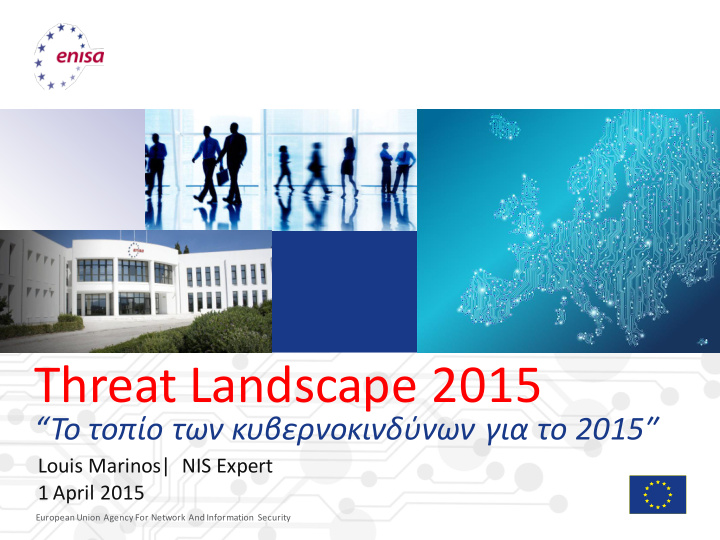



Threat Landscape 2015 “Το τοπίο των κυβερνοκινδύνων για το 2015″ Louis Marinos| NIS Expert 1 April 2015 European Union Agency For Network And Information Security
Subject of the talk The motto of 5 th Infocom Security: Mind the Risk. Be proactive! Define protection needs Adapt your defences 2
Risks, assets, threats, defences… Risk oriented Threat oriented Preventive - Patterns - Big data - Threat - Threat Agents - Triage - Weakness - Attack vectors - Actions - Impact - Kill chains - Controls - Acceptance levels - Trends - Controls Asset oriented Threat Operational Risk/Business Intelligence Intelligence Intelligence
Cyber-Threats/Risks: Basic assumption TA2 TA3 Asset TA1 ETL Scope TA Threat Agent T Threat TA4 Vulnerability Measure Birth of Risks to assets: their exposure to threats
ETL Scope: What are the parts? Threats TA2 TA3 Threat Agents Asset TA1 Attack methods (vectors) TA4 Assets (Mostly technical) Vulnerabilities Controls … and interconnections thereof Our internal Cyber Threat Intelligence! CAUTION: TI IS NOT REPLACEMENT OF RISK MANAGEMENT
Threat Information vs. Intel.
Information types of Threat Intel. • Strategic (S): the highest level information about threats . – Created by humans, consumed by humans – Lifespan months • Tactical (T): at this level, stakeholders obtain aggregated information about threats and their elements. – Created and consumed by humans and machines – Lifespan weeks, months • Operational (O): technical information about threats, incidents, etc. – Created by machines, consumed by machines/humans – Lifespan days, weeks
Why do we need to know? The Pyramid of Pain Types of information Interface ISMS Strategic Tough TTPs Tools Challenging Tactical Network/ Annoying Host Artefacts Interface SIEM Domain Names Simple IP Addresses Operational Easy Hash Values Trivial http://detect-respond.blogspot.gr/2013/03/the-pyramid-of-pain.html
From Threat Info to Intel… ENISA Threat Landscape Threat Find reliable sources Information Collection Isolate and relate similar Threat information Information Collation ENISA Thematic TL Evaluate findings and decide Threat Analysis what to take on board Find out practices, issues, Set Threat Context vulnerabilities, risks, etc. Information Dissemination
How does ENISA do it? Flash Note Fast path..
Top Threats and Trends
Impressive facts: clear text Web is the most popular platform for malware distribution : “ Malicious URL is by far the first malicious object detected (72,9%) ” Ref : (Kaspersky IT Threat Evolution Q2 2014, findings overview: http://securelist.com/analysis/quarterly-malware-reports/65340/it-threat-evolution-q2-2014/) Mail is another important channel for malware distribution : “ Of the e-mail traffic, 13.7% contained malicious URL ” Ref: Symantec Intelligence Report May 2014, http://www.symantec.com/connect/blogs/symantec-intelligence-report- may-2014 Attacks become more effective and targeted : “ Mobile banking Trojans have increased by almost factor four over the year. Since July 2012 14,5 Times ” Ref: (Kaspersky IT Threat Evolution Q2 2014, findings overview: http://securelist.com/analysis/quarterly-malware-reports/65340/it-threat-evolution-q2-2014/) 2014 the year of data breach? “ 57% of the significant data loss over the past decade resulted from what could be termed sloppiness ” Ref : http://capgemini.ft.com/web-review/sloppiness-to-blame-for-more-data-losses-than-hacking- study-claims_a-41-648.html, relevant report http://cmds.ceu.hu/sites/cmcs.ceu.hu/files/attachment/article/663/databreachesineurope.pdf Efficiency of existing controls needs to be increased : “ 54% of malware goes undetected by Antivirus products ” Ref: NTT Global Threat Intelligence Report 2014 (http://www.nttcomsecurity.com/en/services/managed-security- services/threatintelligence/) Sophistication of malware and attacks increases: “ In 2013, 30% of malware samples used custom encryption to steal data. ”, Ref: WebSence Threat Report 2014, http://www.websense.com/content/websense-2014-threat-report.aspx
Take aways … • Understand the scope of your assessments • Identify threat exposure and understand what you can afford • Build TI tool usage models according to points above • Increase agility of assessments and ISMS • Think that current state of TI is still initial BUT has a great potential
Concluding… • Knowledge can be obtained by aggregating and correlating information (needs brain power) • Skill is an amount of knowledge on a certain subject matter (capability building) • A lot of skill is needed in the area of cyber threat intelligence (skill management) • Try to find the right mix (make or buy decisions) • Look for upcoming automation/tool developments • The area has great potential
Thank you for your attention…. louis.marinos@enisa.europa.eu
Recommend
More recommend